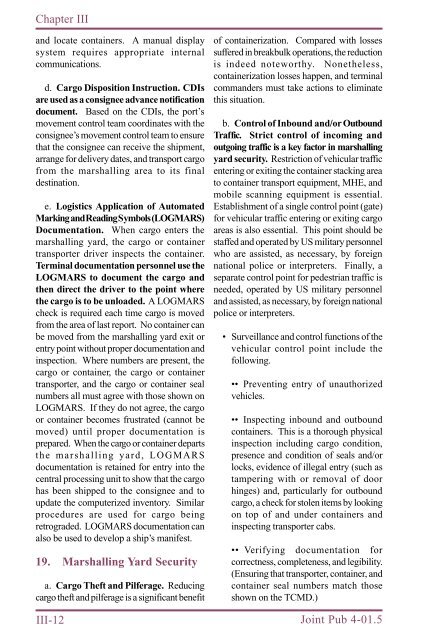JP 4-01.5 JTTP for Water Terminal Operations - BITS
JP 4-01.5 JTTP for Water Terminal Operations - BITS
JP 4-01.5 JTTP for Water Terminal Operations - BITS
Create successful ePaper yourself
Turn your PDF publications into a flip-book with our unique Google optimized e-Paper software.
Chapter III<br />
and locate containers. A manual display<br />
system requires appropriate internal<br />
communications.<br />
d. Cargo Disposition Instruction. CDIs<br />
are used as a consignee advance notification<br />
document. Based on the CDIs, the port’s<br />
movement control team coordinates with the<br />
consignee’s movement control team to ensure<br />
that the consignee can receive the shipment,<br />
arrange <strong>for</strong> delivery dates, and transport cargo<br />
from the marshalling area to its final<br />
destination.<br />
e. Logistics Application of Automated<br />
Marking and Reading Symbols (LOGMARS)<br />
Documentation. When cargo enters the<br />
marshalling yard, the cargo or container<br />
transporter driver inspects the container.<br />
<strong>Terminal</strong> documentation personnel use the<br />
LOGMARS to document the cargo and<br />
then direct the driver to the point where<br />
the cargo is to be unloaded. A LOGMARS<br />
check is required each time cargo is moved<br />
from the area of last report. No container can<br />
be moved from the marshalling yard exit or<br />
entry point without proper documentation and<br />
inspection. Where numbers are present, the<br />
cargo or container, the cargo or container<br />
transporter, and the cargo or container seal<br />
numbers all must agree with those shown on<br />
LOGMARS. If they do not agree, the cargo<br />
or container becomes frustrated (cannot be<br />
moved) until proper documentation is<br />
prepared. When the cargo or container departs<br />
the marshalling yard, LOGMARS<br />
documentation is retained <strong>for</strong> entry into the<br />
central processing unit to show that the cargo<br />
has been shipped to the consignee and to<br />
update the computerized inventory. Similar<br />
procedures are used <strong>for</strong> cargo being<br />
retrograded. LOGMARS documentation can<br />
also be used to develop a ship’s manifest.<br />
19. Marshalling Yard Security<br />
a. Cargo Theft and Pilferage. Reducing<br />
cargo theft and pilferage is a significant benefit<br />
III-12<br />
of containerization. Compared with losses<br />
suffered in breakbulk operations, the reduction<br />
is indeed noteworthy. Nonetheless,<br />
containerization losses happen, and terminal<br />
commanders must take actions to eliminate<br />
this situation.<br />
b. Control of Inbound and/or Outbound<br />
Traffic. Strict control of incoming and<br />
outgoing traffic is a key factor in marshalling<br />
yard security. Restriction of vehicular traffic<br />
entering or exiting the container stacking area<br />
to container transport equipment, MHE, and<br />
mobile scanning equipment is essential.<br />
Establishment of a single control point (gate)<br />
<strong>for</strong> vehicular traffic entering or exiting cargo<br />
areas is also essential. This point should be<br />
staffed and operated by US military personnel<br />
who are assisted, as necessary, by <strong>for</strong>eign<br />
national police or interpreters. Finally, a<br />
separate control point <strong>for</strong> pedestrian traffic is<br />
needed, operated by US military personnel<br />
and assisted, as necessary, by <strong>for</strong>eign national<br />
police or interpreters.<br />
• Surveillance and control functions of the<br />
vehicular control point include the<br />
following.<br />
•• Preventing entry of unauthorized<br />
vehicles.<br />
•• Inspecting inbound and outbound<br />
containers. This is a thorough physical<br />
inspection including cargo condition,<br />
presence and condition of seals and/or<br />
locks, evidence of illegal entry (such as<br />
tampering with or removal of door<br />
hinges) and, particularly <strong>for</strong> outbound<br />
cargo, a check <strong>for</strong> stolen items by looking<br />
on top of and under containers and<br />
inspecting transporter cabs.<br />
•• Verifying documentation <strong>for</strong><br />
correctness, completeness, and legibility.<br />
(Ensuring that transporter, container, and<br />
container seal numbers match those<br />
shown on the TCMD.)<br />
Joint Pub 4-<strong>01.5</strong>
















